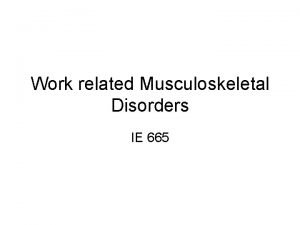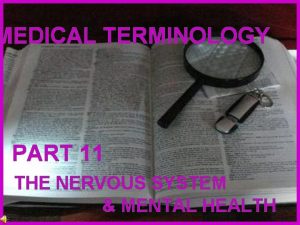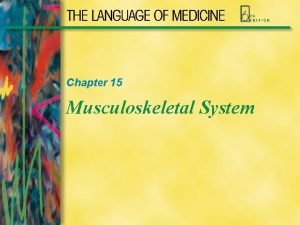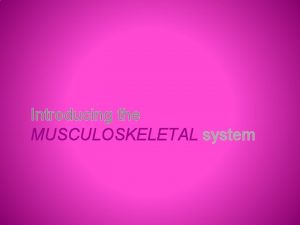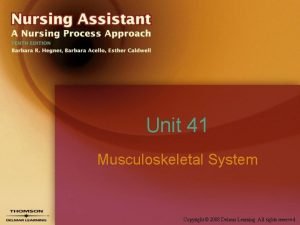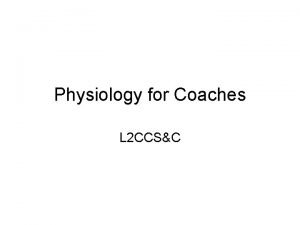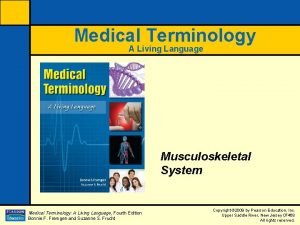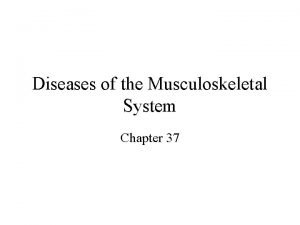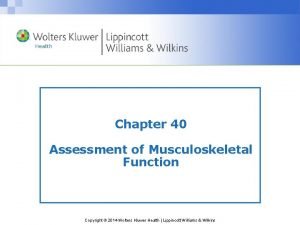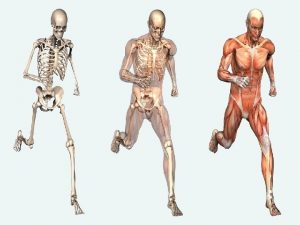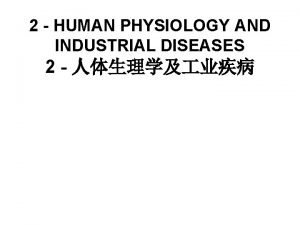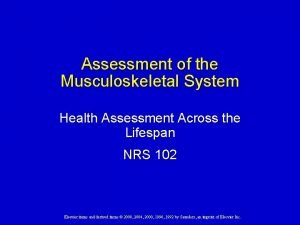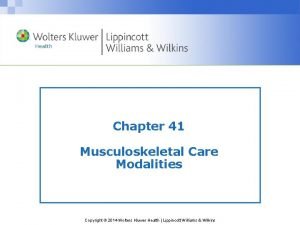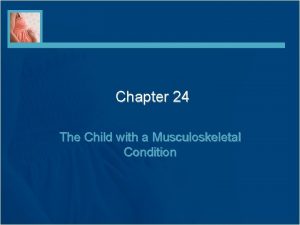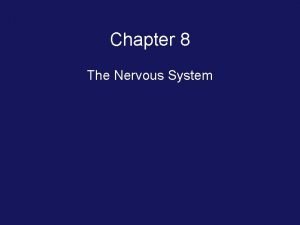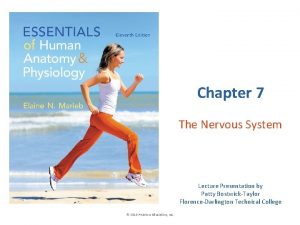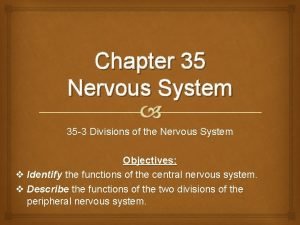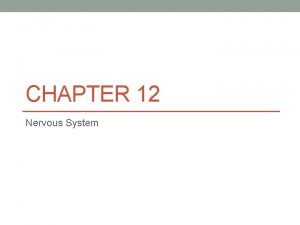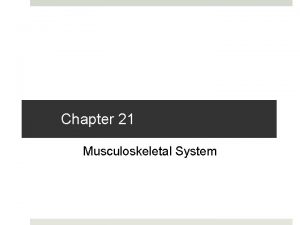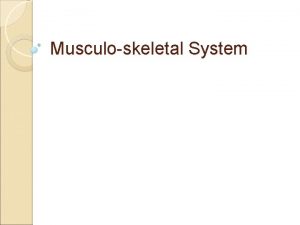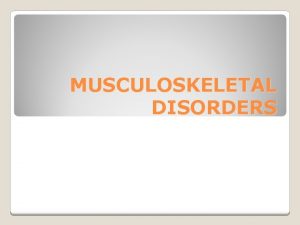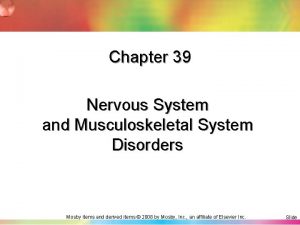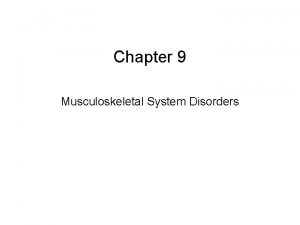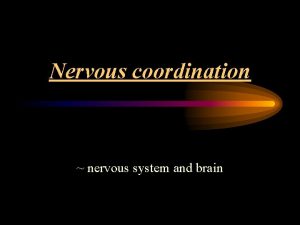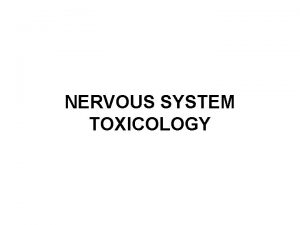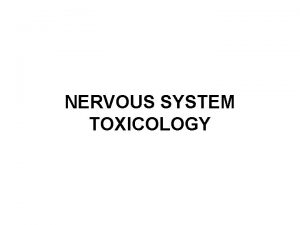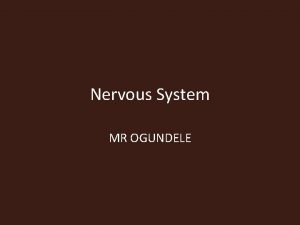Chapter 41 Nervous System and Musculoskeletal Disorders Copyright


![Nervous System Disorders (cont’d) Stroke (brain attack or cerebrovascular accident [CVA]) is a disease Nervous System Disorders (cont’d) Stroke (brain attack or cerebrovascular accident [CVA]) is a disease](https://slidetodoc.com/presentation_image/23bd16a02442a2da08f3a1d51a625469/image-3.jpg)

































- Slides: 36

Chapter 41 Nervous System and Musculo-skeletal Disorders Copyright © 2012 by Mosby, an imprint of Elsevier Inc. All rights reserved.

Nervous System Disorders Nervous system disorders can affect mental and physical function. Ø Nervous system disorders can affect the ability to: • Speak • Understand • Feel • See • Hear • Touch • Think • Control bowels and bladder • Move Copyright © 2012 by Mosby, an imprint of Elsevier Inc. All rights reserved. Slide 2
![Nervous System Disorders contd Stroke brain attack or cerebrovascular accident CVA is a disease Nervous System Disorders (cont’d) Stroke (brain attack or cerebrovascular accident [CVA]) is a disease](https://slidetodoc.com/presentation_image/23bd16a02442a2da08f3a1d51a625469/image-3.jpg)
Nervous System Disorders (cont’d) Stroke (brain attack or cerebrovascular accident [CVA]) is a disease that affects the arteries that supply blood to the brain. Ø Stroke occurs when one of the following happens. • A blood vessel in the brain bursts. Bleeding occurs in the brain (cerebral hemorrhage). A blood clot blocks blood flow to the brain. • Ø Stroke is the third leading cause of death in the United States. • It is a leading cause of disability in adults. Ø Warning signs may last a few minutes. • This is called a transient ischemic attack (TIA). Copyright © 2012 by Mosby, an imprint of Elsevier Inc. All rights reserved. Slide 3

Nervous System Disorders (cont’d) Ø Stroke risk factors include: • High blood pressure • Cigarette smoking; exposure to second-hand smoke • Heart disease • Diabetes • TIAs • Age 55 and older • Being over-weight • Lack of physical activity Copyright © 2012 by Mosby, an imprint of Elsevier Inc. All rights reserved. Slide 4

Nervous System Disorders (cont’d) Ø Stroke can occur suddenly. • The person may have warning signs. Sudden numbness or weakness of the face, arm, or leg, especially on one side of the body Sudden confusion, trouble speaking, or understanding speech Sudden trouble seeing in one or both eyes Sudden trouble walking, dizziness, loss of balance or coordination Sudden severe headache with no known cause Copyright © 2012 by Mosby, an imprint of Elsevier Inc. All rights reserved. Slide 5

Nervous System Disorders (cont’d) Ø If the person survives, some brain damage is likely. • Functions lost depend on the area of brain damage. • Rehabilitation starts at once. • The health team helps the person regain the highest possible level of function. Copyright © 2012 by Mosby, an imprint of Elsevier Inc. All rights reserved. Slide 6

Nervous System Disorders (cont’d) Parkinson’s disease is a slow, progressive disorder with no cure. Ø Ø Movement is affected. Persons over the age of 50 are at risk. Signs and symptoms become worse over time. They include: • Tremors • Rigid, stiff muscles in the arms, legs, neck, and trunk • Slow movements • Stooped posture and impaired balance • Mask-like expression Other signs and symptoms develop over time. Copyright © 2012 by Mosby, an imprint of Elsevier Inc. All rights reserved. Slide 7

Nervous System Disorders (cont’d) Ø Treatment includes: • Drugs to treat and control the disease • Exercise and physical therapy to improve strength, posture, balance, and mobility Therapy for speech and swallowing problems • Ø The person may need help with eating and selfcare. Ø Normal elimination is a goal. Ø Safety measures are needed to prevent falls and injuries. Copyright © 2012 by Mosby, an imprint of Elsevier Inc. All rights reserved. Slide 8

Nervous System Disorders (cont’d) Multiple sclerosis (MS) is a chronic disease. Ø The myelin, which covers nerve fibers in the brain and spinal cord, is destroyed. • Nerve impulses are not sent to and from the brain in a normal way. Ø There is no cure. Copyright © 2012 by Mosby, an imprint of Elsevier Inc. All rights reserved. Slide 9

Nervous System Disorders (cont’d) Signs and symptoms may include: Ø Ø Ø Ø Blurred or double vision, blindness in one eye Muscle weakness in the arms and legs Balance and coordination problems Tingling, prickling, or numb sensations Partial or complete paralysis Pain Speech problems Ø Ø Ø Ø Tremors Dizziness Concentration, attention, memory, and judgment problems Depression Bowel and bladder problems Problems with sexual function Hearing loss Fatigue Copyright © 2012 by Mosby, an imprint of Elsevier Inc. All rights reserved. Slide 10

Nervous System Disorders (cont’d) Ø MS can present in many ways. For example: • The person’s symptoms last for a few weeks or a few • • Ø months. The symptoms gradually disappear with partial or complete recovery. The person is in remission. At some point, symptoms flare up again (relapse). The person’s condition gradually declines with more and more symptoms. There are no remissions. Symptoms become worse. More symptoms occur with each flare-up. The person’s condition declines. Persons with MS are kept active as long as possible and as independent as possible. • The care plan reflects the person’s changing needs. Copyright © 2012 by Mosby, an imprint of Elsevier Inc. All rights reserved. Slide 11

Nervous System Disorders (cont’d) Amyotrophic lateral sclerosis (ALS) is a disease that attacks the nerve cells that control voluntary muscles. Ø Ø Commonly called Lou Gehrig’s disease, it is rapidly progressive and fatal. ALS is more common in men. It usually strikes between 40 and 60 years of age. Motor nerve cells in the brain, brainstem, and spinal cord are affected. • These cells stop sending messages to the muscles. • Muscles weaken, waste away (atrophy), and twitch. Copyright © 2012 by Mosby, an imprint of Elsevier Inc. All rights reserved. Slide 12

Nervous System Disorders (cont’d) Ø Ø Ø Over time, the brain cannot start voluntary movements or control them. The disease usually does not affect the mind, intelligence, or memory. Sight, smell, taste, hearing, and touch are not affected. ALS has no cure. • Some drugs can slow disease and improve symptoms. Persons with ALS are kept active and independent to the extent possible. • The care plan reflects the person’s changing needs. Copyright © 2012 by Mosby, an imprint of Elsevier Inc. All rights reserved. Slide 13

Nervous System Disorders (cont’d) Head injuries result from trauma to the scalp, skull, or brain. Ø Ø Ø Traumatic brain injury (TBI) occurs when a sudden trauma damages the brain. • Brain tissue is bruised or torn. • Bleeding can be in the brain or in nearby tissues. • Spinal cord injuries are likely. Causes include: • Motor vehicle crashes • Falls • Assaults • Firearms • Sports and recreation injuries Death can occur at the time of injury or later. • If the person survives, some permanent damage is likely. Copyright © 2012 by Mosby, an imprint of Elsevier Inc. All rights reserved. Slide 14

Nervous System Disorders (cont’d) Ø Disabilities depend on the severity and site of the injury. They include: • Cognitive problems • Sensory problems • Communication problems • Behavior or mental health problems • Stupor—an unresponsive state; the person can be briefly aroused • Coma—the person is unconscious, does not respond, is unaware, • • Ø and cannot be aroused Vegetative state—the person is unconscious and unaware of surroundings. He or she has sleep-wake cycles and periods of being alert Persistent vegetative state (PVS)—the person is in a vegetative state for more than 1 month Rehabilitation is required. Copyright © 2012 by Mosby, an imprint of Elsevier Inc. All rights reserved. Slide 15

Nervous System Disorders (cont’d) Spinal cord injuries can permanently damage the nervous system. Young adult men have the highest risk. Ø Common causes are: • Stab or gunshot wounds • Motor vehicle crashes • Falls • Sports injuries Ø Problems depend on the: • Amount of damage to the spinal cord • Level of injury Ø Copyright © 2012 by Mosby, an imprint of Elsevier Inc. All rights reserved. Slide 16

Nervous System Disorders (cont’d) Ø The higher the level of injury, the more functions lost. • Lumbar injuries—sensory and muscle function in the legs is lost (paraplegia). Ø • Thoracic injuries—sensory and muscle function below the chest is lost (paraplegia). • Cervical injuries—sensory and muscle function of the arms, legs, and trunk are lost (quadriplegia or tetraplegia). If the person lives, rehabilitation is needed. • The person learns to function at the highest possible level. • The person learns to use self-help, assistive, and other devices. • Some persons live independently at home or with home care. • Some persons need long-term care or assisted-living settings. Copyright © 2012 by Mosby, an imprint of Elsevier Inc. All rights reserved. Slide 17

Nervous System Disorders (cont’d) Autonomic dysreflexia occurs with spinal cord injuries above the mid-thoracic level. There is uncontrolled stimulation of the sympathetic nervous system. Ø If untreated, stroke, heart attack, and death are risks. Ø Treatment involves: • Raising the head of the bed 45 degrees or having the Ø person sit upright if allowed Determining and removing the cause • Ø The most common causes are: • A full bladder • Constipation or fecal impaction • Skin disorders Copyright © 2012 by Mosby, an imprint of Elsevier Inc. All rights reserved. Slide 18

Musculo-skeletal Disorders Musculo-skeletal disorders affect movement. Ø Injury and aging are common causes. Arthritis means joint inflammation. It is the most common joint disease. Ø Pain, swelling, and stiffness occur. Ø The joints are hard to move. Ø Copyright © 2012 by Mosby, an imprint of Elsevier Inc. All rights reserved. Slide 19

Musculo-skeletal Disorders (cont’d) Osteoarthritis (degenerative joint disease) is the most common type of arthritis. Causes include: • Aging • Being over-weight • Joint injury • Stress • Muscle weakness • Heredity Ø Signs and symptoms include: • Joint stiffness occurs with rest and lack of motion. • Pain occurs with weight-bearing and motion. • Swelling is common after using the joint. Ø There is no cure. Ø Copyright © 2012 by Mosby, an imprint of Elsevier Inc. All rights reserved. Slide 20

Musculo-skeletal Disorders (cont’d) Ø Treatment involves: • Drugs to decrease swelling and inflammation and relieve pain Heat and sometimes cold applications Exercise Rest and joint care Weight control Healthy life-style Joint replacement surgery • • • Ø Falls are prevented. Ø Help is given with ADL as needed. Copyright © 2012 by Mosby, an imprint of Elsevier Inc. All rights reserved. Slide 21

Musculo-skeletal Disorders (cont’d) Rheumatoid arthritis (RA) is a chronic inflammatory disease. Ø Ø Ø Ø Ø It causes joint pain, swelling, stiffness, and loss of function. RA is more common in women than in men. It usually develops between the ages of 20 and 50. RA occurs on both sides of the body. Joints are tender, warm, and swollen. Fatigue and fever are common. Symptoms may last for many years. Other body parts may be affected. RA varies from person to person. Copyright © 2012 by Mosby, an imprint of Elsevier Inc. All rights reserved. Slide 22

Musculo-skeletal Disorders (cont’d) Treatment goals are to: • Relieve pain. • Reduce inflammation. • Slow down or stop joint damage. • Improve well-being and ability to function. Ø The person’s care plan may include: • Rest balanced with exercise • Proper positioning • Joint care • Weight control • Measures to reduce stress • Measure to prevent falls Ø Copyright © 2012 by Mosby, an imprint of Elsevier Inc. All rights reserved. Slide 23

Musculo-skeletal Disorders (cont’d) Ø Ø Drugs are given for pain relief and inflammation. Heat and cold applications may be ordered. Some persons need joint replacement surgery. Emotional support is needed. Copyright © 2012 by Mosby, an imprint of Elsevier Inc. All rights reserved. Slide 24

Musculo-skeletal Disorders (cont’d) Total joint replacement surgery Arthroplasty is the surgical replacement of a joint. Ø The damaged joint is removed and replaced with an artificial joint. • The artificial joint is called a prosthesis. Ø The surgery is done to: • Relieve pain. • Restore joint function. • Correct a deformed joint. Ø Copyright © 2012 by Mosby, an imprint of Elsevier Inc. All rights reserved. Slide 25

Musculo-skeletal Disorders (cont’d) Osteoporosis With osteoporosis, the bone becomes porous and brittle. • Bones are fragile and break easily. Ø Older people are at risk. • The risk for women increases after menopause. Ø All ethnic groups are at risk. Ø Copyright © 2012 by Mosby, an imprint of Elsevier Inc. All rights reserved. Slide 26

Musculo-skeletal Disorders (cont’d) Ø Ø Other risk factors include: • A family history of the disease • Being thin or having a small frame • Eating disorders • Tobacco use • Alcoholism • Lack of exercise • Bedrest • Immobility Signs and symptoms include: • Back pain • Gradual loss of height • Stooped posture • Fractures Copyright © 2012 by Mosby, an imprint of Elsevier Inc. All rights reserved. Slide 27

Musculo-skeletal Disorders (cont’d) Ø Preventive measures include: • Calcium and vitamin supplements • Estrogen for some women • Exercising weight-bearing joints • Strength training • Not smoking • Limiting alcohol and caffeine • Back supports or corsets for good posture • Walking aids if needed • Safety measures to prevent falls and accidents • Good body mechanics • Safe moving, transfer, and turning and positioning procedures Copyright © 2012 by Mosby, an imprint of Elsevier Inc. All rights reserved. Slide 28

Musculo-skeletal Disorders (cont’d) Fractures A fracture is a broken bone. Ø Fractures are open or closed. • Closed fracture (simple fracture)—the bone is broken Ø • Ø but the skin is intact. Open fracture (compound fracture)—the broken bone has come through the skin. Causes include: • Falls and accidents • Bone tumors • Metastatic cancer • Osteoporosis Copyright © 2012 by Mosby, an imprint of Elsevier Inc. All rights reserved. Slide 29

Musculo-skeletal Disorders (cont’d) Ø Signs and symptoms of a fracture are: • Pain • Swelling • Loss of function • Limited or no movement of the part • Movement where motion should not occur • Deformity • Bruising and skin color changes at the fracture site • Bleeding (internal or external) Copyright © 2012 by Mosby, an imprint of Elsevier Inc. All rights reserved. Slide 30

Musculo-skeletal Disorders (cont’d) Ø For healing, bone ends are brought into and held in normal position. • This is called reduction or fixation. Ø Closed reduction and external fixation—the bone is moved back into place; the bone is not exposed. Open reduction and internal fixation—requires surgery; the bone is exposed and moved into alignment. After reduction, the bone ends must not move. • The person has a cast or traction. • Splints, walking boots, and external fixators are also used. Copyright © 2012 by Mosby, an imprint of Elsevier Inc. All rights reserved. Slide 31

Musculo-skeletal Disorders (cont’d) Casts are made of plaster of paris, plastic, or fiberglass. Ø Traction • A steady pull from two directions keeps the bone in place. • Traction also is used for muscle spasms and to correct Ø • • • deformities or contractures. Weights, ropes, and pulleys are used. Traction is applied to the neck, arms, legs, or pelvis. Skin traction is applied to the skin. Skeletal traction is inserted through the bone. For cervical traction, tongs are applied to the skull. Copyright © 2012 by Mosby, an imprint of Elsevier Inc. All rights reserved. Slide 32

Musculo-skeletal Disorders (cont’d) Hip fractures Ø Ø Fractured hips are common in older persons. • Older women are at risk. Healing is slower in older people. These post-operative problems present lifethreatening risks. • Respiratory complications • Urinary tract infections • Thrombi (blood clots) in the leg veins Other risks include pressure ulcers, constipation, and confusion. Copyright © 2012 by Mosby, an imprint of Elsevier Inc. All rights reserved. Slide 33

Musculo-skeletal Disorders (cont’d) The fracture requires internal fixation. Ø Some hip fractures require partial or total hip replacement. • Adduction, internal rotation, external rotation, and Ø severe hip flexion are avoided after surgery. Ø Rehabilitation is usually needed after a hip fracture. Copyright © 2012 by Mosby, an imprint of Elsevier Inc. All rights reserved. Slide 34

Musculo-skeletal Disorders (cont’d) Loss of limb An amputation is the removal of all or part of an extremity. Ø Most amputations involve a lower extremity. Ø Common causes include: • Severe injuries • Tumors • Severe infection • Gangrene • Vascular disorders Ø Copyright © 2012 by Mosby, an imprint of Elsevier Inc. All rights reserved. Slide 35

Musculo-skeletal Disorders (cont’d) Ø Ø Ø Gangrene is the death of tissue. • Causes include infection, injuries, and vascular disorders. • Surgery is needed to remove dead tissue. • If untreated, gangrene spreads throughout the body. • Gangrene can cause death. A prosthesis is an artificial replacement for a missing body part. The person may feel that the amputated limb is still there. • The person may complain of pain in the amputated part (phantom pain). Ø Lower limb amputations are common in older persons. • After amputation, most need long-term care on a temporary or permanent basis. Copyright © 2012 by Mosby, an imprint of Elsevier Inc. All rights reserved. Slide 36
 Chapter 6 musculoskeletal system diseases and disorders
Chapter 6 musculoskeletal system diseases and disorders Chapter 15 nervous system diseases and disorders
Chapter 15 nervous system diseases and disorders Work related musculoskeletal disorders definition
Work related musculoskeletal disorders definition Identify each type of neuronal pool
Identify each type of neuronal pool Sensory input and motor output
Sensory input and motor output Processes of nerve cell
Processes of nerve cell Disorders of the nervous system
Disorders of the nervous system Chapter 21 the musculoskeletal system
Chapter 21 the musculoskeletal system Chapter 15 musculoskeletal system step by step
Chapter 15 musculoskeletal system step by step Chapter 17 reproductive system diseases and disorders
Chapter 17 reproductive system diseases and disorders Cardiovascular system diseases and disorders chapter 8
Cardiovascular system diseases and disorders chapter 8 10 diseases of lymphatic system
10 diseases of lymphatic system Nervous system and digestive system
Nervous system and digestive system Adh function
Adh function Endocrine system and nervous system
Endocrine system and nervous system Types of joint movement
Types of joint movement Unit 41 musculoskeletal system
Unit 41 musculoskeletal system Musculoskeletal system
Musculoskeletal system Medical term for top of foot
Medical term for top of foot Diseases of the musculoskeletal system
Diseases of the musculoskeletal system Assessment of the musculoskeletal system
Assessment of the musculoskeletal system Assessment of the musculoskeletal system
Assessment of the musculoskeletal system Musculoskeletal system
Musculoskeletal system Objective data for musculoskeletal system
Objective data for musculoskeletal system Chapter 40 musculoskeletal care modalities
Chapter 40 musculoskeletal care modalities Buck's extension traction
Buck's extension traction Amino acid-based hormones
Amino acid-based hormones Componentes componentes
Componentes componentes Chapter 8 the nervous system
Chapter 8 the nervous system Chapter 7 the nervous system figure 7-2
Chapter 7 the nervous system figure 7-2 Chapter 35 nervous system
Chapter 35 nervous system Chapter 14 the skeletal muscular and nervous systems
Chapter 14 the skeletal muscular and nervous systems Chapter 12 nervous system
Chapter 12 nervous system Define a primary skin lesion and list three types
Define a primary skin lesion and list three types Chapter 46 digestive and endocrine disorders
Chapter 46 digestive and endocrine disorders Types of somatic disorder
Types of somatic disorder Chapter 29 endocrine and metabolic disorders
Chapter 29 endocrine and metabolic disorders


